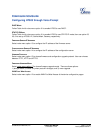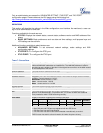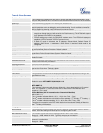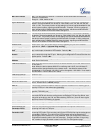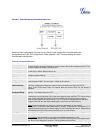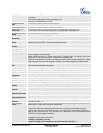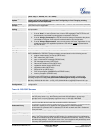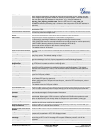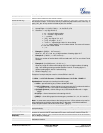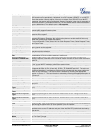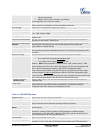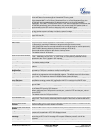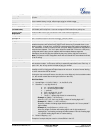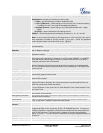
Grandstream Networks, Inc. HT503 User Manual Page 25 of 38
Firmware 1.0.4.2 Last Updated: 06/2011
SIP User ID
User account information, provided by VoIP service provider (ITSP), usually has the
form of digit similar to phone number or actually a phone number. This field contains
the user part of the SIP address for this phone. e.g., if the SIP address is
sip:my_user_id@my_provider.com, then the SIP User ID is: my_user_id.
Do NOT include the preceding “sip:” scheme or the host portion of the SIP address in
this field.
Authenticate ID
ID used for authentication, usually same as SIP user ID, but could be different and
decided by ITSP.
Authentication Password
Password for ATA to register to (SIP) servers of ITSP. Purposely left blank once saved
for security. Maximum length is 25.
Name
SIP service subscriber’s name which will be used for Caller ID display
DNS mode
One from the 3 modes available for “DNS Mode” configuration:
-A Record (for resolving IP Address of target according to domain name)
-SRV (DNS SRV resource records indicates how to find services for various protocols)
-NAPTR/SRV (Naming Authority Pointer according to RFC 2915)
One mode can be chosen for the client to look up server.
The default value is “A Record”
User ID is Phone Numbe
r
If “Yes” is set, a “user=phone” parameter will be attached to the “From” header in SIP
request
SIP Registration
This parameter controls whether the HT503 needs to send REGISTER messages to
the proxy server. The default setting is “Yes”.
Unregister on Reboot Default is No. If set to yes, the device will first send registration request to remove all
previous bindings. Use only if proxy supports this remove bindings request.
Outgoing Call w/o
Registration
This parameter allows users place outgoing calls even when not registered (if allowed
by ITSP) but it’s unable to receive incoming calls.
Register Expiration
This parameter allows the user to specify the time frequency (in minutes) the
HandyTone ATA refreshes its registration with the specified registrar. The default
interval is 60 minutes (or 1 hour). The maximum interval is 65535 minutes (about 45
days).
Local SIP port
This parameter defines the local SIP port the HT503 will listen and transmit. The default
value for FXS port is 5060.
Local RTP port
This parameter defines the local RTP-RTCP port pair used by the HandyTone ATA. It
is the base RTP port for channel 0.
When configured, the FXS port will use this port _value for RTP and the port_value+1
for its RTCP.
The default value for FXS port is 5004.
Use Random Port Default is No. If set to Yes, the device will pick randomly-generated SIP and RTP ports.
This is usually necessary when multiple HandyTone ATAs are behind the same NAT.
Refer to Use Target
Contact
Default is No. If set to “Yes”, then for Attended Transfer, the “Refer-To” header uses
the transferred target’s Contact header information.
Transfer on conference
hangup
Default is No. In which case if conference originator hangs up the conference will be
terminated. When option YES is chosen, originator will transfer other parties to each
other so that B and C can choose either to continue the conversation or hang up.
Enable Ring-Transfe
r
Default is No, this will create a Semi-Attendant Transfer. When set to Yes, device can
transfer the call upon receiving ring back tone.
Disable Bellcore Style 3-
Way Conference
Default is No. you can make a Conference by pressing ‘Flash’ key. If set to Yes, you
need to dial *23 + second callee number.
Remove OBP from Route
Header
Default is No. If set to Yes, the Outbound Proxy will be removed from the route header.
Support SIP instance ID Default is Yes. If set to Yes, the contact header in REGISTER request will contain SIP
Instance ID as defined in IETF SIP Outbound draft.
V
alidate incoming SIP
message
Default is No. If set to yes all incoming SIP messages will be strictly validated
according to RFC rules. If message will not pass validation process, call will be
rejected.
Check SIP User ID for
Default is No. Check the incoming SIP User ID in Request URI. If they don’t match, the



